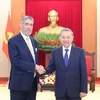Khanh Hoa (VNA) - Continuing its agenda, the first Asia-Pacific Economic (APEC) Senior Officials Meeting (SOM1) will hear and discuss an array of reports during the March 2 afternoon session.
Delegates to SOM1 are expected to hear the Committee on Trade and Investment (CTI) Chair’s report on the outcomes of its first meeting, including the CTI’s priority areas and work plan for 2017.
They will discuss ways APEC can support the multilateral trading system (MTS) and contribute to the 11th World Trade Organisation (WTO) Ministerial Conference, as well as ways to further deepen regional economic integration (REI), including the acceleration of work to achieve the Bogor Goals in the next steps towards the eventual realisation of an Free Trade Area of the Asia-Pacific (FTAAP).
SOM1 is to deliberate progress in implementing the APEC Services Competitiveness Roadmap (ASCR), including the way forward on the reporting and monitoring of its implementation.
Also during the course of the session, SOM1 plans to discuss the reports of the Friends of the Chair (FotC) on Connectivity and the Ad Hoc Steering Group on the Internet Economy (AHSGIE)’s Chair. It will also debate trade and investment facilitation and liberalization work, and task the CTI to coordinate with the Policy Support Unit (PSU) to design the monitoring framework for Supply-chain Connectivity Framework Action Plan (SCFAP) Phase II.
The delegates are scheduled to hear the SOM Steering Committee on Economic and Technical Cooperation (SCE) Chair’s report on SCE’s deliberations at SCE and SCE-COW (Committee of the Whole) meetings, including the SCE’s priorities and work plan for 2017.
SOM1 will also exchange views on initiatives to facilitate micro-, small- and medium-sized enterprises’ (MSMEs) greater participation in global value chains (GVCs), the business environment for MSMEs in the digital age, and the progress in the development of the Strategy on green and sustainable MSMEs.
Earlier, in the morning session, SOM1 endorsed the EC Chair’s report and noted the work plans of the Finance Ministers’ Process and ABAC in 2017; the outcomes of the EC Policy Dialogue on Government Procurement; the proposal on promoting economic, financial and social inclusion in the APEC region; the proposal on “APEC Framework on Human Resources Development in the Digital Age”, and the proposal on “Bridging Gap in Economic Development and Integration of Remote Areas for Sustainable Growth in the APEC Region”.
The APEC forum includes 21 members - Australia, Brunei, Canada, Chile, China, Hong Kong (China), Indonesia, Japan, the Republic of Korea, Malaysia, Mexico, New Zealand, Papua New Guinea, Peru, the Philippines, Russia, Singapore, Chinese Taipei, Thailand, the US and Vietnam.
By the end of November 2016, the APEC member economies accounted for 39 percent of the world’s population and made up 59 percent of the world’s gross domestic product (GDP) and 48 percent of the global trade value.-VNA
























